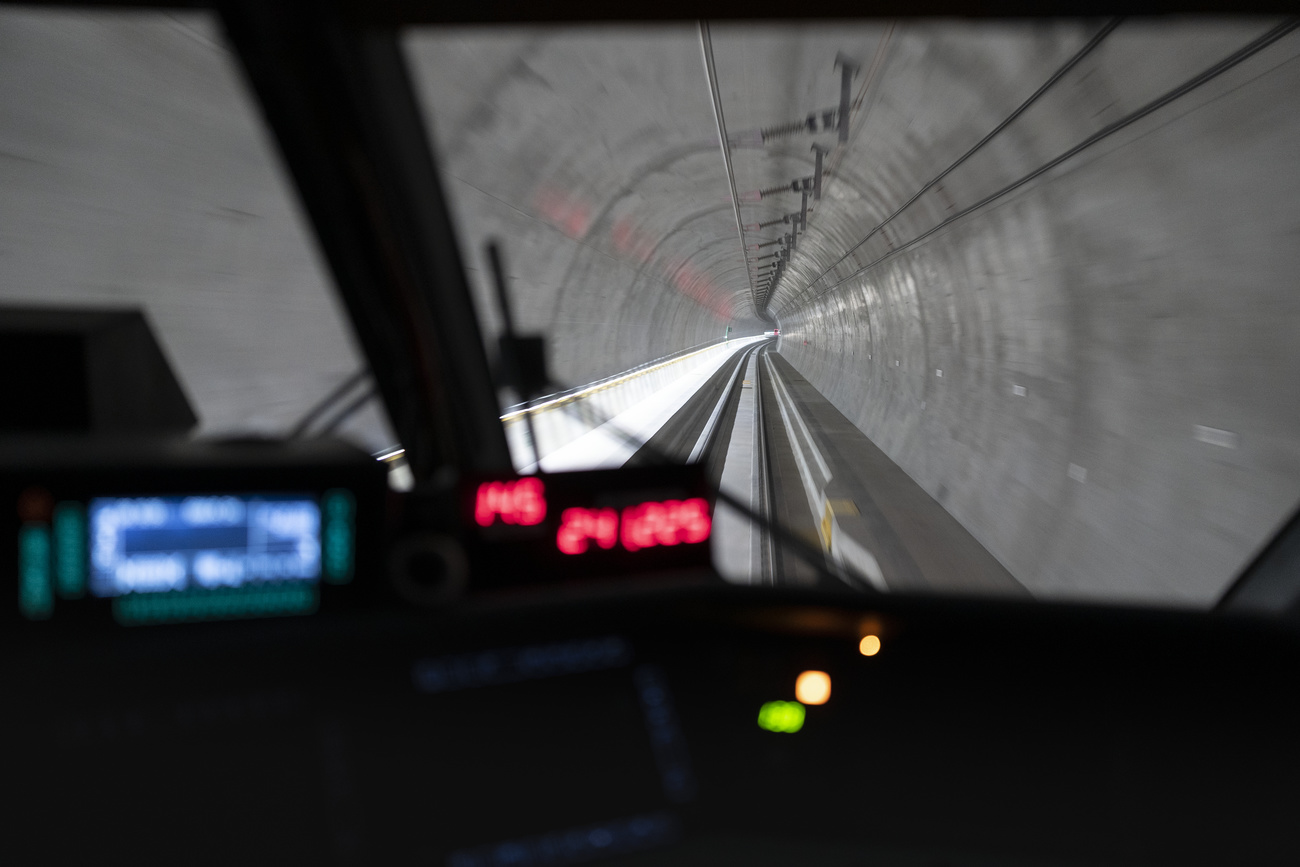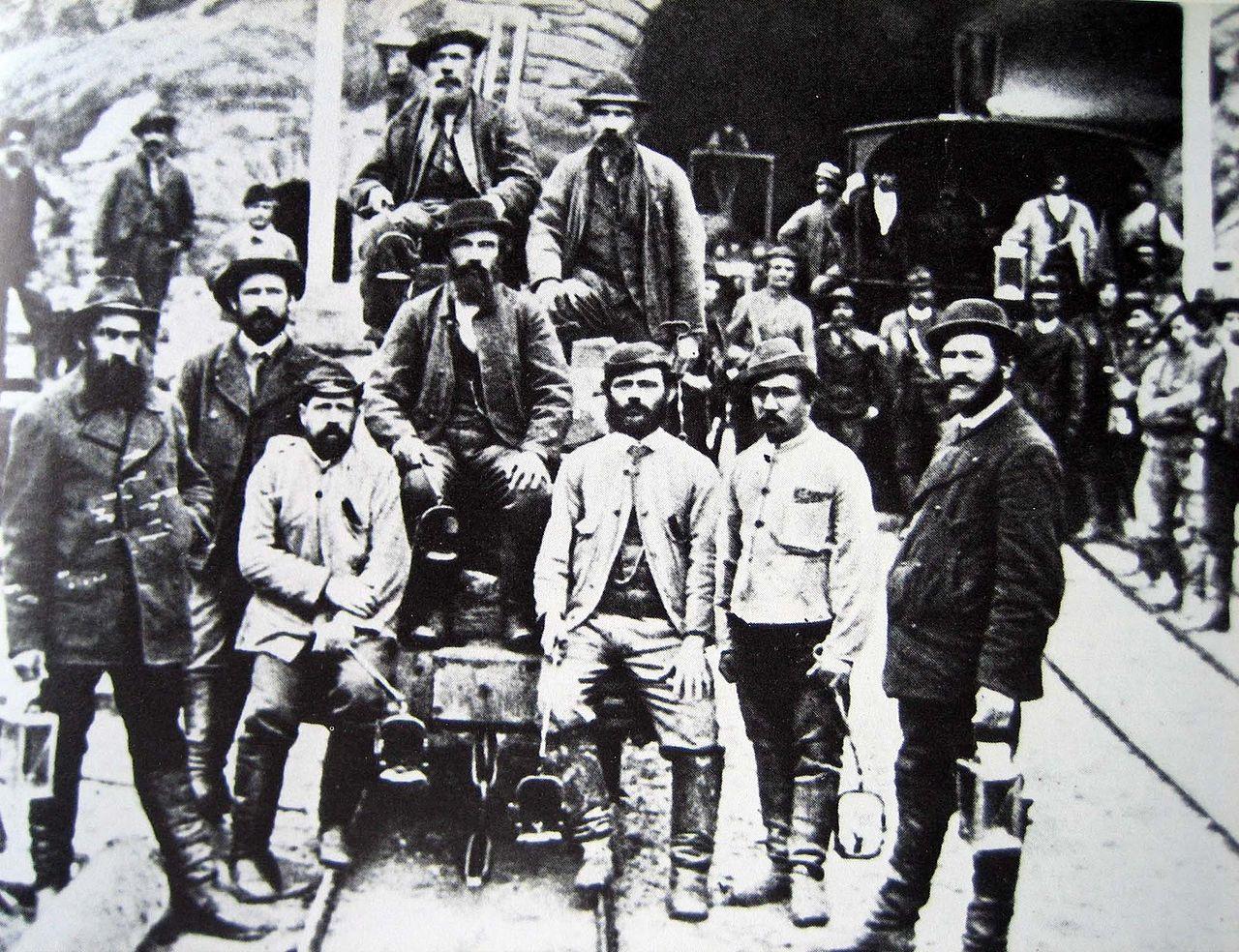
As tunnel opens, transport project of the century becomes reality

With the inauguration of the Ceneri base tunnel, the finishing touches are being put on the most colossal infrastructure project in recent Swiss history.
The Swiss definitely like to burrow. If you were to add up the distance covered by all the longest railway tunnels in the country, it would be enough to travel underground across almost the entire national territory from Chiasso to Basel – several hundred kilometres.
In particular, the 56km Gotthard base tunnel, inaugurated with great pomp in 2016, continues to enjoy the title of world’s longest – a title it will hold onto for at least another decade, until the Brenner tunnel links Italy and Austria.
Now Switzerland’s collection is about to welcome a new addition: the 15.4-kilometre Mount Ceneri tunnel, where the ribbon is to be cut on September 4 in a scaled-down, Covid-conscious ceremony.
For travellers, the change will only become a reality when the national rail timetable changes in December, at which point the tunnel will come into use. Then, due to more coronavirus-linked delays, we will have to wait until April 2021 to see all the connections in place.
According to the federal office of transport, quoting 1998 prices, the NEAT project will cost CHF17.7 billion ($19.42 billion). This figure is in line with the 1992 estimate put before voters of CHF15 billion, which did not allow for price increases and other changes.
At current prices (that is, allowing for price rises, VAT, and construction interest rates), the whole project is likely to cost CHF22.8 billion. On its own, the Mount Ceneri tunnel cost about CHF3.6 billion to complete.
Compared to the figures for the Gotthard or Lötschberg (34.6km), the Monte Ceneri seems like small fry. But two decades ago, its 15.4km would have put it in the world’s top 10 by length. By the end of this decade, when other projects like the Fréjus or the Brenner are completed, it will be about 30th in the world rankings.
Revolution
The inauguration of the Ceneri is the final step in an engineering adventure that started 30 years ago. Indeed, the Alpine rail link project to upgrade connections between northern and southern Europe – including the Lötschberg, Gotthard and Ceneri tunnels – is a good example of how the Swiss political system can get things done.
Because, with all its endless delays and compromises, the Swiss direct democracy system has a significant advantage: once a project has been ratified by voters, it can be implemented without further delay. In contrast to similar projects elsewhere – the Turin-Lyon line, for example, blocked by opposition groups – the Alpine rail link project has never become a target of protests or demonstrations.
After voters accepted it with a 63.6% majority in 1992, the project simply proceeded without further ado. Those opposed for financial or environmental reasons, notably the Greens, accepted the verdict of the ballot box without reservation.

More
Democracy made world’s longest tunnel possible
The opening of the Ceneri tunnel also means a transport revolution for the southern canton of Ticino. Travel time between Bellinzona and Lugano will be cut by a third, from 27 to 19 minutes. From Lugano to Locarno the savings will be even greater, down from 50 to 29 minutes. Furthermore, regional rail lines will be upgraded, and some reckon the change could lead to the creation of a “Ticino City” – one big urban sprawl across the canton.
The impact will be significant on international traffic, too. From next year, travellers will be able to get to Milan from Zurich in less than three-and-a-half hours. When other projects are completed, including on the Italian side, this time will drop to 3 hours – that’s 40 minutes less than what it is now. With the opening of the Gotthard base tunnel in 2016, the time taken for the journey was already cut by half an hour.
The chart below concerns the Gotthard and not the Ceneri, but gives an impression of how things have changed over a few decades.
Off the road, onto the rails
Reduction of travel time is only one of the goals of the Alpine rail link project. The other, just as important and in fact written into Switzerland’s constitution after the “Alpine initiative” approved by voters in 1994, is to get heavy goods traffic off the road and onto rail.
That legislation stipulates that the number of heavy vehicles crossing the Alps annually be reduced from 1.4 million in the year 2000 to 650,000 – an objective that should have been reached two years after the opening of the Gotthard tunnel. However, though the number of heavy vehicles is dropping, the target is still a long way away.
The base tunnels are the key component of this strategy. On the one hand, they allow for an increase in the number of tracks devoted to goods trains, and on the other hand, since these lines run on level ground, they allow an increase in the length of trains, from 500m to 740m.
The Ceneri tunnel will also helps this: it will enable an upgrade of the line between Chiasso and Milan, giving goods traffic on the north-south corridor an additional outlet – on top of the usual Lötschberg/Simplon and Bellinzona/Luino/Gallarate routes.
However, there is no reason to expect a sudden surge in road-to-rail transfer. The new Ceneri tunnel, though a key building-block in the transfer policy, is not a magic wand. For one thing, rail is not the solution for all transport needs. And for another, having tunnels which represent the state of the art in rail technology are of little use without adequate access routes to get to them.
With that in mind, a great deal has already been done to bring surrounding infrastructure up to scratch. The so-called 4-metre corridor (in Europe, more and more goods are carried on 4-metre-high trailers, and tunnels have to be modified accordingly) is practically finished. This includes in neighbouring Italy, where large-scale works have taken place between Bellinzona and Gallarate thanks to Swiss contributions.
Obstacles remain, particularly on the line between the Ceneri and Milan. South of Lugano, trains will still have to slow down on a line dating from 1874, with nothing likely to change here before 2050. Between Chiasso and Milan, meanwhile, investments of several hundred million are planned to increase the capacity of lines. Nevertheless, investment in physical infrastructure like new rails and switches has not been given a firm date.
The situation is more complicated in southern Germany, where there have been considerable delays in the project to widen the Rhine Valley stretch to four tracks. Hupac, the biggest European player in inter-modal transport, says that this situation will not now allow for the passage of trains of 740m. The transport revolution might still take a while.
Translated from Italian by Terence MacNamee

In compliance with the JTI standards
More: SWI swissinfo.ch certified by the Journalism Trust Initiative































Join the conversation!